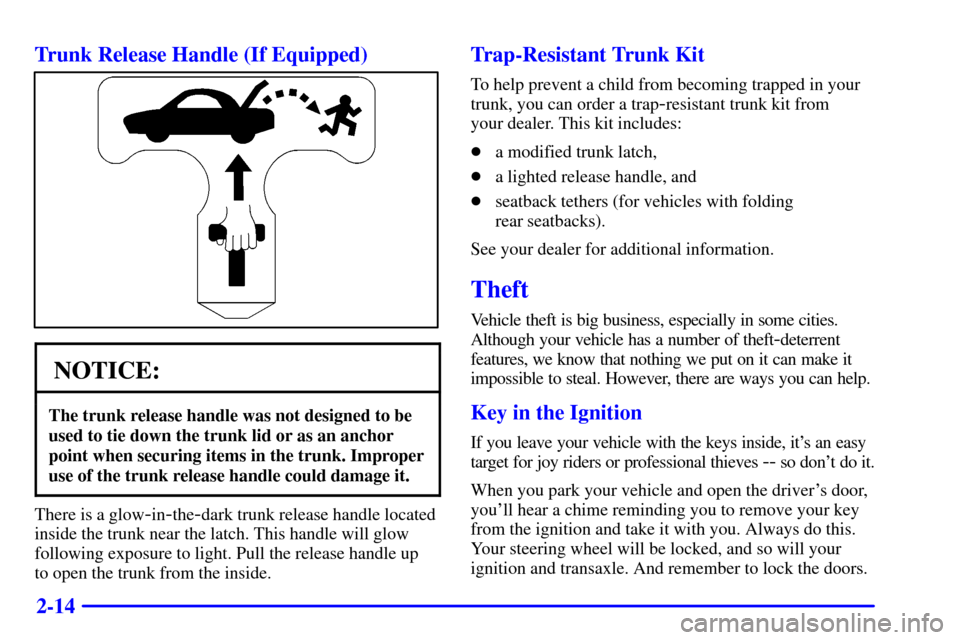Page 62 of 335

2-
2-1
Section 2 Features and Controls
Here you can learn about the many standard and optional features on your vehicle, and information on starting,
shifting and braking. Also explained are the instrument panel and the warning systems that tell you if everything is
working properly
-- and what to do if you have a problem.
2
-2 Windows
2
-4 Keys
2
-6 Door Locks
2
-8 Remote Keyless Entry System
2
-12 Trunk
2
-14 Theft
2
-15 Theft-Deterrent System
2
-17 PASS-Key� II
2
-18 New Vehicle ªBreak-Inº
2
-19 Ignition Positions
2
-20 Starting Your Engine
2
-21 Engine Coolant Heater (If Equipped)
2
-23 Automatic Transaxle Operation
2
-26 Parking Brake
2
-28 Shifting Into PARK (P)
2
-30 Shifting Out of PARK (P)2
-31 Parking Over Things That Burn
2
-31 Engine Exhaust
2
-32 Running Your Engine While You're Parked
2
-33 Tilt Wheel
2
-33 Turn Signal/Multifunction Lever
2
-41 Exterior Lamps
2
-46 Interior Lamps
2
-47 Mirrors
2
-51 Storage Compartments
2
-53 Sun Visors
2
-54 OnStar� System (If Equipped)
2
-57 Sunroof (Option)
2
-58 HomeLink� Transmitter (Option)
2
-62 The Instrument Panel -- Your
Information System
2
-66 Warning Lights, Gages and Indicators
2
-76 Driver Information Center (DIC)
Page 75 of 335

2-14 Trunk Release Handle (If Equipped)
NOTICE:
The trunk release handle was not designed to be
used to tie down the trunk lid or as an anchor
point when securing items in the trunk. Improper
use of the trunk release handle could damage it.
There is a glow-in-the-dark trunk release handle located
inside the trunk near the latch. This handle will glow
following exposure to light. Pull the release handle up
to open the trunk from the inside.
Trap-Resistant Trunk Kit
To help prevent a child from becoming trapped in your
trunk, you can order a trap
-resistant trunk kit from
your dealer. This kit includes:
�a modified trunk latch,
�a lighted release handle, and
�seatback tethers (for vehicles with folding
rear seatbacks).
See your dealer for additional information.
Theft
Vehicle theft is big business, especially in some cities.
Although your vehicle has a number of theft
-deterrent
features, we know that nothing we put on it can make it
impossible to steal. However, there are ways you can help.
Key in the Ignition
If you leave your vehicle with the keys inside, it's an easy
target for joy riders or professional thieves
-- so don't do it.
When you park your vehicle and open the driver's door,
you'll hear a chime reminding you to remove your key
from the ignition and take it with you. Always do this.
Your steering wheel will be locked, and so will your
ignition and transaxle. And remember to lock the doors.
Page 76 of 335

2-15 Parking at Night
Park in a lighted spot, close all windows and lock your
vehicle. Remember to keep your valuables out of sight.
Put them in a storage area, or take them with you.
Parking Lots
Even if you park in a lot where someone will be watching
your vehicle, it's still best to lock it up and take your keys.
But what if you have to leave your ignition key?
�If possible, park in a busy, well
-lit area.
�Put your valuables in a storage area, like your
trunk or glove box. Be sure to close and lock the
storage area.
�Close all windows.
�Press the valet lockout button to ON.
�Lock the glove box.
�Lock all the doors except the driver's.
�Then take the door key and remote keyless entry
transmitter with you.
Theft-Deterrent System
If the ignition is off and
either door is open, the
SECURITY light will flash,
reminding you to activate
the system.
The light will also flash if the battery has been
disconnected and reconnected.
To activate the theft
-deterrent system, do the following:
1. Open the door.
2. Lock the door using the power door lock or the
remote keyless entry transmitter. The SECURITY
light should come on and stay on.
3. Close both doors. The SECURITY light should go
off within about 30 seconds.
The horn will sound and the lamps will flash for about
30 seconds when a door or the trunk is opened without
the key or the remote keyless entry transmitter. The horn
also sounds if the locks are damaged.
Page 77 of 335

2-16
Remember, the theft-deterrent system won't activate if
you lock a door with a key or use the manual door lock.
It activates only if you use a power door lock switch or
the remote keyless entry transmitter.
To avoid activating the alarm by accident, do
the following:
�Always unlock a door with a key or use the remote
keyless entry transmitter. (Pressing the unlock button
on the remote keyless entry transmitter disables the
theft
-deterrent system.) Unlocking a door any other
way will activate the alarm. Cycling the ignition
without disarming the theft
-deterrent system will
also activate the alarm.
�The vehicle should be locked with the door key after
the doors are closed if you don't want to activate the
theft
-deterrent system.
If you activate the alarm by accident, unlock either door
with your key. You can also turn off the alarm by using
the unlock button of the remote keyless entry
transmitter. The alarm won't stop if you try to unlock a
door any other way.
Testing the Alarm
1. From inside the vehicle, roll down the window, then
get out of the vehicle, keeping the door open.
2. From outside of the vehicle, with the door open,
lock the vehicle using the power door lock or the
remote keyless entry transmitter and close the door.
Wait 30 seconds until the SECURITY light goes off.
3. Reach in and unlock the door using the manual lock
and open the door. The horn will sound and the
headlamps will flash.
If the alarm does not sound when it should, check to
see if the horn works. The horn fuse may be blown.
To replace the fuse, see ªFuses and Circuit Breakersº in
the Index. If the fuse does not need to be replaced, you
may need to have your vehicle serviced.
To reduce the possibility of theft, always activate the
theft
-deterrent system when leaving your vehicle.
Page 87 of 335
2-26
FIRST (1): This position gives you even more power
than SECOND (2). You can use it on very steep hills,
or in deep snow or mud. (If the shift lever is put in
FIRST (1), the transaxle won't shift into gear until the
vehicle is going slowly enough.)
NOTICE:
If your front wheels can't rotate, don't try to
drive. This might happen if you were stuck in
very deep sand or mud or were up against a solid
object. You could damage your transaxle.
Also, if you stop when going uphill, don't hold
your vehicle there with only the accelerator
pedal. This could cause overheating and damage
the transaxle. Use your brakes to hold your
vehicle in position on a hill.
Parking Brake
Hold the regular brake
pedal down with your right
foot and push down the
parking brake pedal with
your left foot to set the
parking brake.
If the ignition is on, the BRAKE indicator light
should come on. If it doesn't, you need to have
your vehicle serviced.
Page 88 of 335

2-27
If the parking brake has not been fully released and
you try to drive with the parking brake on, the
BRAKE indicator light comes on and stays on.
See ªBrake System Warning Lightº in the Index for
more information.
When you move out of PARK (P) or NEUTRAL (N),
if the engine is running, the parking brake should
release. If it doesn't, you can manually release the
parking brake.
CAUTION:
Always shift to PARK (P) before pulling the
manual release lever. If your hand or arm is in
the way of the pedal you could be hurt. The pedal
springs back quickly. Keep your hand and arm
away when you use the manual release lever.
Be sure to turn off the ignition and put the vehicle in
PARK (P) before manually releasing the brake.
Reach under the driver's side of the instrument panel
and pull on the manual release lever, which is located
above the parking brake pedal. If the parking brake does
not release, you should either drive to the nearest service
station or have your vehicle towed.
Page 95 of 335

2-34 Turn and Lane Change Signals
To signal a turn, move the lever all the way up or
down. The lever returns automatically when the turn
is complete.
An arrow located on the
instrument panel cluster will
flash in the direction of the
turn or lane change.
Raise or lower the lever until the arrow starts to flash to
signal a lane change. Hold it there until the lane change
is complete. The lever returns when it's released.
If the turn signal is left on, a warning chime will sound
and the Driver Information Center (DIC) will display
TURN SIGNAL ON (after driving about 1 mile
(1.6 km/h)) to remind you to turn it off.Arrows that flash rapidly when signaling for a turn or
lane change may be caused by a burned
-out signal bulb.
Other drivers won't see the turn signal.
Replace burned
-out bulbs to help avoid possible
accidents. Check the fuse (see ªFuses and Circuit
Breakersº in the Index) and for burned
-out bulbs if the
arrow fails to work when signaling a turn.
Headlamp High/Low Beam Changer
This light located on the
instrument panel panel will
be on when the high beam
headlamps are in use.
Pull the turn signal lever all the way toward you and
then release it to change the headlamps from low beam
to high or from high beam to low.
Page 97 of 335

2-36
OFF: Turn the band to OFF to turn off the wipers.
Be sure to clear ice and snow from the wiper blades
before using them. If they're frozen to the windshield,
carefully loosen or thaw them. If the blades do become
damaged, get new blades or blade inserts.
Heavy snow or ice can overload the wiper motor.
A circuit breaker will stop the motor until it cools.
Clear away snow or ice to prevent an overload.
Rainsense�II Wipers (ETC Only)
The moisture sensor is mounted on the interior side of
the windshield behind the rearview mirror and is used to
automatically operate the wipers by monitoring the
amount of moisture build
-up on the windshield.Wipes occur as needed to clear the windshield
depending on driving conditions and the sensitivity
setting. In light rain or snow, fewer wipes will occur. In
heavy rain or snow, wipes will occur more frequently.
The Rainsense wipers operate in a delay mode as well as
a continuous low or high speed depending as needed.
If the system is left on for long periods of time,
occasional wipes may occur without any moisture on
the windshield. This is normal and indicates that the
Rainsense system is activated.
The Rainsense system can be activated by turning the
wiper stalk to one of the five sensitivity levels within the
AUTO DELAY area. The AUTO DELAY position closest
to OFF is the lowest sensitivity setting, level one. This
allows more rain or snow to collect on the windshield
between wipes. Turning the stalk away from you to the
higher levels of other AUTO DELAY settings increases
the sensitivity of the system and frequency of wipes. The
highest sensitivity setting, level five is closest to LO. A
single wipe will occur each time you turn the wiper stalk
to a higher sensitivity level to indicate that the sensitivity
level has been increased. An initial wipe occurs when you
turn the ignition on as a reminder that Rainsense is active.
The windshield wipers also remain in a ªhigh parkº
position (when the wipers are stopped on the windshield
and are not in the normal park position), even when the
ignition is turned off.